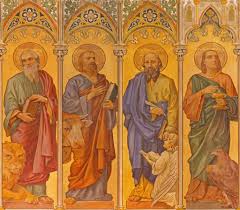By Michael Nyavi (Sir Michael)
Introduction
The first three books of the New Testament—Matthew, Mark, and Luke are commonly referred to as the Synoptic Gospels. The term synoptic comes from the Greek words syn (“together”) and opsis (“view”), meaning “to see together.” These three Gospels are called synoptic because they share a striking similarity in content, structure, and wording, allowing them to be viewed side by side for comparison. Despite their similarities, each Gospel has unique characteristics, theological emphases, and audiences. The study of the Synoptic Gospels is essential for understanding the life, teachings, death, and resurrection of Jesus Christ, as well as for appreciating the diversity of early Christian witness.
This article explores the origins, characteristics, similarities, differences, theological themes, and scholarly debates surrounding the Synoptic Gospels, providing a comprehensive understanding of their importance in the New Testament canon.
Origins of the Synoptic Gospels
The Synoptic Gospels were composed during the first century A.D., within the context of the Greco-Roman world and the Jewish religious tradition. Scholars generally date Mark as the earliest Gospel, written around 65–70 A.D., followed by Matthew and Luke, usually dated between 80–90 A.D. (Brown, 1997). The purpose of these writings was not merely historical reporting but also theological interpretation—proclaiming Jesus as the Messiah, Son of God, and Savior.
The Synoptics were written for different audiences:
- Matthew was likely written for a Jewish-Christian audience, emphasizing Jesus as the fulfillment of Old Testament prophecy.
- Mark appears to have been directed to a Roman audience, stressing the suffering Messiah and the cost of discipleship.
- Luke addressed a Gentile audience, portraying Jesus as the Savior for all humanity, with a particular concern for the poor, marginalized, and outsiders.
Similarities Among the Synoptic Gospels
The close relationship among the three Gospels is most evident in their parallel accounts. Over 90% of Mark’s content appears in Matthew, while about 50% of Mark is found in Luke (Stein, 2001). This high degree of overlap raises questions about literary dependence and shared sources.
Key Similarities:
- Narrative Structure: All three Gospels follow a similar chronological framework—beginning with John the Baptist’s ministry, followed by Jesus’ baptism, teaching, miracles, passion, death, and resurrection.
- Common Sayings and Teachings: Many of Jesus’ sayings, such as the parables of the Sower and the Mustard Seed, appear in all three.
- Miracle Stories: Accounts of Jesus’ healing the sick, casting out demons, and calming the storm occur in parallel forms.
- Passion Narrative: The trial, crucifixion, and resurrection accounts share significant similarities, though with minor differences in detail.
These commonalities suggest that the evangelists either used one another’s work or drew from shared oral and written traditions.
Differences Among the Synoptic Gospels
Despite the similarities, each Gospel maintains unique theological emphases and editorial choices.
- Matthew: Strongly emphasizes Jesus as the “New Moses.” The Sermon on the Mount (Matthew 5–7) contains a collection of teachings not found in Mark, presenting Jesus as the authoritative interpreter of the Law. Matthew also stresses the fulfillment of Old Testament prophecies, often using the phrase, “This was to fulfill what was spoken by the prophet.”
- Mark: Mark’s Gospel is shorter and more fast-paced, using the Greek word euthys (“immediately”) frequently. It presents Jesus as the “Suffering Servant” and emphasizes the Messianic Secret—Jesus often instructs people not to disclose His identity.
- Luke: Luke highlights themes of compassion, social justice, and inclusivity. The parables of the Good Samaritan and the Prodigal Son are unique to Luke. He also gives special attention to women, the poor, and Gentiles. Moreover, Luke traces Jesus’ genealogy back to Adam, underscoring His universal mission.
The Synoptic Problem
The similarities and differences among the Synoptic Gospels have given rise to what scholars call the Synoptic Problem—the question of how these texts are related literarily.
Major Theories:
- Two-Source Hypothesis: The most widely accepted theory suggests that Mark was written first, and both Matthew and Luke used Mark as a source. Additionally, Matthew and Luke shared another source, commonly called Q (from the German Quelle, meaning “source”), which contained sayings of Jesus not found in Mark (Farmer, 1976).
- Farrer Hypothesis: This theory argues that Mark was first, Matthew used Mark, and then Luke used both Mark and Matthew—thus eliminating the need for Q.
- Griesbach Hypothesis: Also known as the Two-Gospel Hypothesis, it proposes that Matthew was first, Luke used Matthew, and Mark then condensed both.
While the Synoptic Problem remains debated, most scholars lean toward the Two-Source Hypothesis.
Theological Themes in the Synoptic Gospels
Though they share a common framework, each Gospel uniquely contributes to Christian theology.
- Christology:
- Matthew highlights Jesus as the Messiah and King.
- Mark portrays Him as the suffering Son of Man.
- Luke emphasizes His role as the universal Savior.
- Kingdom of God: The central theme in all Synoptics is the Kingdom of God, portrayed as both a present reality and a future hope.
- Discipleship: Mark underscores the cost of following Jesus, Matthew stresses obedience to His teachings, and Luke focuses on mission and service.
- Fulfillment of Scripture: Especially in Matthew, Jesus is portrayed as fulfilling the Law and the Prophets, connecting Him to Israel’s history.
- Inclusivity and Compassion: Luke, in particular, emphasizes Jesus’ ministry to the marginalized, showing that salvation is available to all.
Importance of the Synoptic Gospels
The Synoptic Gospels are crucial to Christianity for several reasons:
- Historical Foundation: They provide the earliest written accounts of Jesus’ life and teachings.
- Doctrinal Formation: They shaped early Christian doctrine, worship, and ethics.
- Liturgical Use: They continue to play a central role in Christian liturgy and preaching.
- Ecumenical Relevance: Their shared content fosters unity across Christian traditions.
- Biblical Scholarship: They are central to the field of biblical studies, especially in debates about historical Jesus and Gospel origins.
Conclusion
The Synoptic Gospels—Matthew, Mark, and Luke stand as indispensable witnesses to the life and mission of Jesus Christ. While they share significant similarities in narrative and teaching, they also preserve distinct theological emphases that enrich our understanding of Jesus. The Synoptic Problem continues to invite scholarly inquiry, but beyond academic debates, these Gospels remain vital for faith, theology, and the Christian witness across the world.
Their message transcends historical analysis: Jesus Christ is the fulfillment of God’s promises, the suffering servant, and the Savior for all humanity. As such, the Synoptic Gospels continue to inspire, instruct, and shape the faith of millions around the globe.
References
- Brown, R. E. (1997). An Introduction to the New Testament. New York: Doubleday.
- Farmer, W. R. (1976). The Synoptic Problem: A Critical Analysis. New York: Macmillan.
- Stein, R. H. (2001). Studying the Synoptic Gospels: Origin and Interpretation. Grand Rapids: Baker Academic.
- Tuckett, C. M. (2001). Q and the History of Early Christianity: Studies on Q. Edinburgh: T&T Clark.
- Wright, N. T. (1996). Jesus and the Victory of God. Minneapolis: Fortress Press.




https://shorturl.fm/E5lTI
https://shorturl.fm/e7Hq4